Following the previous article, according to the idea of "automatic operation and maintenance scheme for terminal delivery", https://blog.csdn.net/yyz_1987/article/details/118358038
Take the above sending terminal status as an example, record the simple use of go zero micro service, and realize a simple background monitoring cloud service.
Create a new directory of Golang service background project code, named monitor.
Gateway layer implementation
According to the use mode of goctl code generated artifact, first define the interface field information to be submitted by the terminal:
statusUpload.api
type (
//Content of terminal status report
StatusUploadReq {
Sn string `json:"sn"` //Equipment unique number
Pos string `json:"pos"` //Terminal number
City string `json:"city"` //City Code
Id string `json:"id"` //Terminal type
Unum1 uint `json:"unnum"` //Number of records not transmitted -- bus
Unum2 uint `json:"unnum"` //Quantity of records not transferred -- Third Party
Ndate string `json:"ndate"` //current date
Ntime string `json:"ntime"` //current time
Amount uint `json:"amount"` //Total on duty
Count uint `json:"count"` //Number of people on duty
Line uint `json:"line"` //Line number
Stime string `json:"stime"` //Startup time
Ctime string `json:"ctime"` //Shutdown time
Tenant uint `json:"tenant"` //Tenant ID
}
//Response content
StatusUploadResp {
Code int `json:"code"`
Msg string `json:"msg"`
Cmd int `json:"cmd"` //Control terminal command word
}
)
service open-api {
@doc(
summary: Open api function
desc: >statusUpload Terminal status reporting
)
@server(
handler: statusUploadHandler
folder: open
)
post /open/statusUpload(StatusUploadReq) returns(StatusUploadResp)
}Next, with the power of goctl artifact, directly generate the gateway layer code:
goctl api go -api statusUpload.api -dir .
The directory structure of generated code is as follows:

Next, run and try:
go run open.go
The gateway layer is started successfully. Listen on port 8888 and open API in the etc folder Configuration in yaml file

Measure with postman and curl tools respectively:
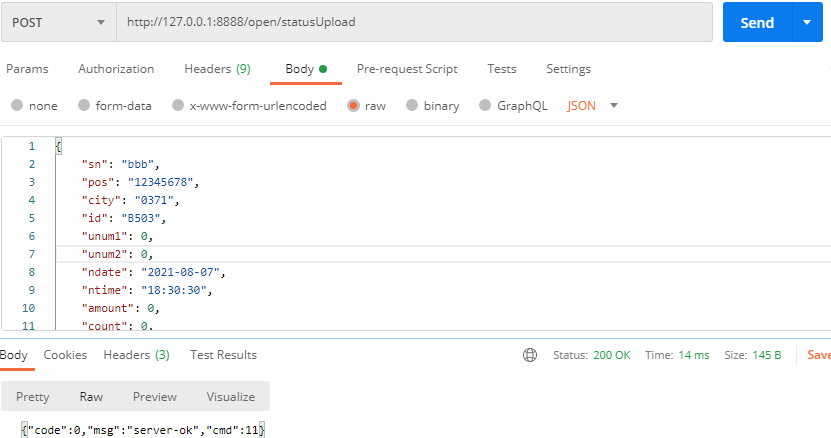
curl http://127.0.0.1:8888/open/statusUpload -X POST -H "Content-Type: application/json" -d @status.json
status.json file content:
{
"sn": "1C2EB08D",
"pos": "12345678",
"city": "0371",
"id": "B503",
"unum1": 0,
"unum2": 0,
"ndate": "2021-08-07",
"ntime": "18:30:30",
"amount": 0,
"count": 0,
"line": 101,
"stime": "05:01:01",
"ctime": "18:30:20",
"tenant": 0
}RPC server implementation
Next, transform it into a microservice, and call the interface provided by the service through rpc. The general structure is as follows:
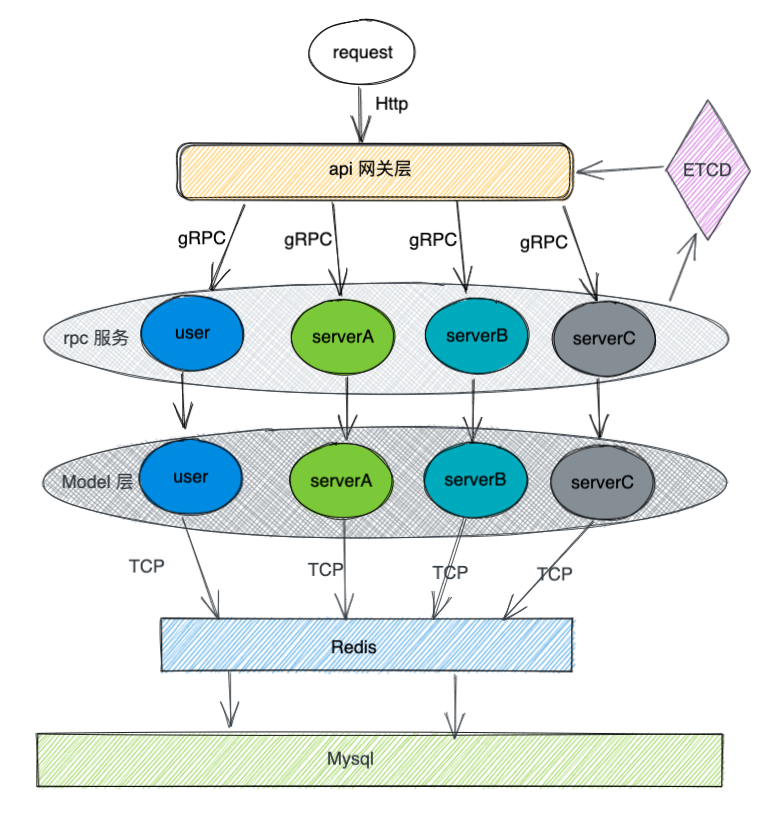
The etcd environment needs to be installed in advance, and some plug-in tools need to be installed, such as proto Exe and proto Gen go Exe tool, put it in the bin directory of go or gopath.
Create an rpc folder under the project code directory and create a code directory on the microservice side, which is called status here.
Define the proto file, status Proto is as follows:
syntax = "proto3";
package status;
message statusUploadReq {
string sn = 1;
string pos = 2;
string city = 3;
string id = 4;
uint32 unum1 = 5;
uint32 unum2 = 6;
string ndate = 7;
string ntime = 8;
uint32 amount = 9;
uint32 count = 10;
uint32 line = 11;
string stime = 12;
string ctime = 13;
uint32 tenant = 14;
}
message statusUploadResp {
int32 code = 1;
string msg = 2;
int32 cmd = 3;
}
service statusUploader {
rpc statusUpload(statusUploadReq) returns(statusUploadResp);
}Then the goctl artifact became powerful and automatically generated code. Isn't it powerful?
goctl rpc proto -src=status.proto -dir .
The automatically generated file directory is as follows:
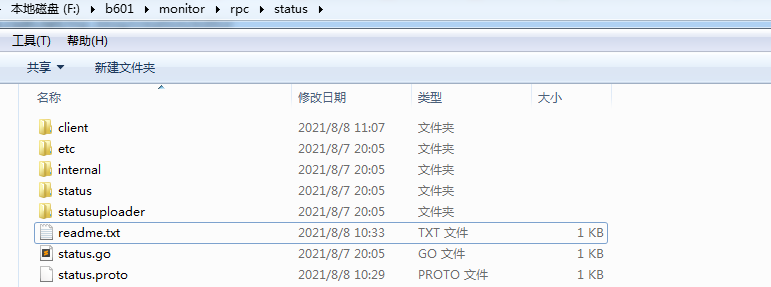
The client folder is not included. The client folder is created by me to test the rpc service separately. I will make a demo on the client side to call the rpc service.
Automatically generate rpc server status Go entry file content:
package main
import (
"flag"
"fmt"
"monitor/rpc/status/internal/config"
"monitor/rpc/status/internal/server"
"monitor/rpc/status/internal/svc"
"monitor/rpc/status/status"
"github.com/tal-tech/go-zero/core/conf"
"github.com/tal-tech/go-zero/zrpc"
"google.golang.org/grpc"
)
var configFile = flag.String("f", "etc/status.yaml", "the config file")
func main() {
flag.Parse()
var c config.Config
conf.MustLoad(*configFile, &c)
ctx := svc.NewServiceContext(c)
srv := server.NewStatusUploaderServer(ctx)
s := zrpc.MustNewServer(c.RpcServerConf, func(grpcServer *grpc.Server) {
status.RegisterStatusUploaderServer(grpcServer, srv)
})
defer s.Stop()
fmt.Printf("Starting rpc server at %s...\n", c.ListenOn)
s.Start()
}
At this time, if etcd is started, go run status Go, the server starts successfully.
RPC client test
To verify that the rpc server works normally, implement a zrpc client in the client folder to test:
client.go files are as follows:
package main
import (
"context"
"fmt"
"github.com/tal-tech/go-zero/core/discov"
"github.com/tal-tech/go-zero/zrpc"
"log"
pb "monitor/rpc/status/status"
)
func main() {
client := zrpc.MustNewClient(zrpc.RpcClientConf{
Etcd: discov.EtcdConf{
Hosts: []string{"127.0.0.1:2379"},
Key: "status.rpc",
},
})
sclient := pb.NewStatusUploaderClient(client.Conn())
reply, err := sclient.StatusUpload(context.Background(), &pb.StatusUploadReq{Sn: "test rpc", Pos: "go-zero"})
if err != nil {
log.Fatal(err)
}
fmt.Println(reply.Msg)
}
If the service is normal, you will receive a response from the server interface.
The gateway layer call is changed to micro service call
The gateway layer can be transformed into the invocation mode of micro services. The changes are not significant, as follows:
Step 1:
The config file under the api\internal\config path in the api directory and the open api. Config file under api\etc Yaml file changes:

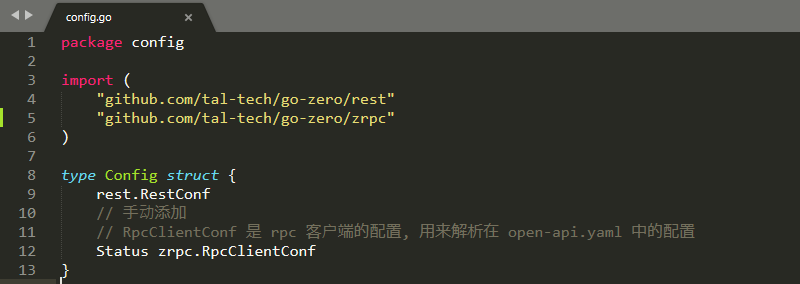
Step 2:
Servicecontext. In the api directory api\internal\svc path Go file changes:
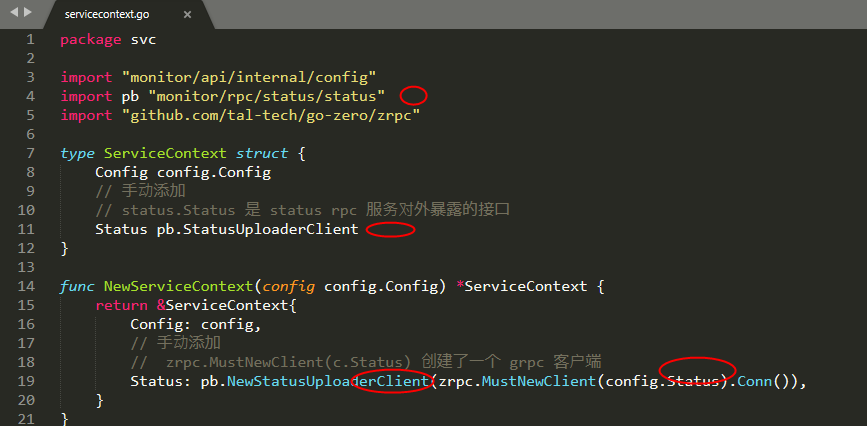
Step 3:
Statusuploadlogic. In the api\internal\logic directory Go file changes,
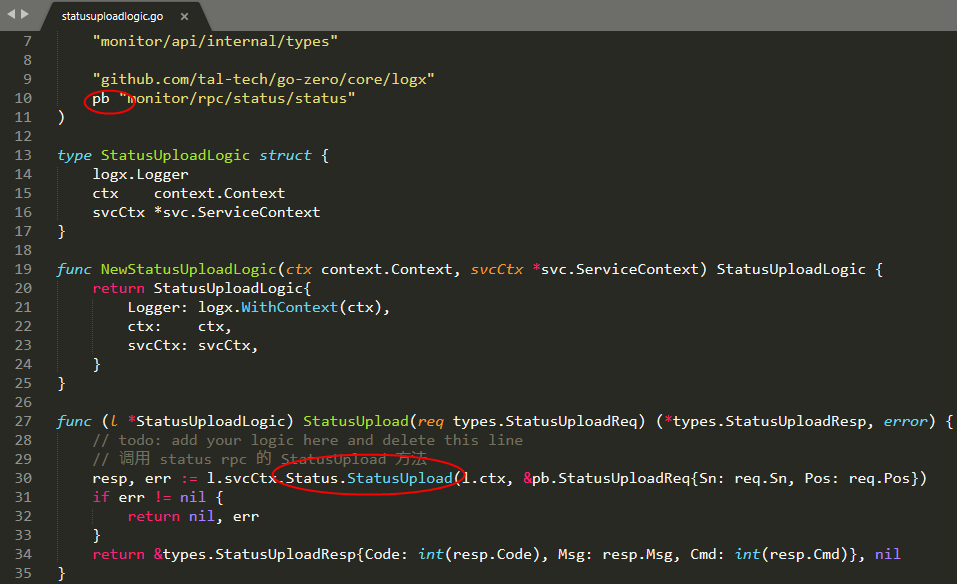
So far, the transformation of api gateway layer is completed. You can simulate the access gateway interface address
curl http://127.0.0.1:8888/open/statusUpload -X POST -H "Content-Type: application/json" -d @status.json